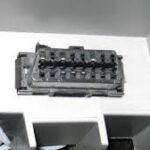The error code P2452 is a diagnostic trouble code (DTC) that can be triggered in vehicles equipped with a diesel engine and a Diesel Particulate Filter (DPF) system. This code falls under the EOBD/OBDII (European On-Board Diagnostics / On-Board Diagnostics II) standards, which are used globally to standardize vehicle diagnostics. Specifically, P2452 indicates an issue with the Diesel Particulate Filter Pressure Sensor “A” Circuit. But what does this mean for your vehicle, and what steps should you consider? Let’s delve deeper into understanding this error.
To grasp the significance of the P2452 code, it’s crucial to understand the role of the Diesel Particulate Filter (DPF) and the Exhaust Pressure Sensor in modern diesel vehicles. Diesel engines, while fuel-efficient, produce particulate matter (soot) and nitrogen oxides (NOx) as byproducts of combustion. To meet stringent emission standards, systems like the DPF and Selective Catalytic Reduction (SCR) using Diesel Exhaust Fluid (DEF) are employed.
The DPF is designed to trap and remove soot particles from the exhaust. This process is essential to prevent the release of harmful particulate matter into the atmosphere. Periodically, the accumulated soot needs to be burned off through a process called regeneration. This regeneration process requires raising the exhaust system temperature to very high levels to incinerate the soot into less harmful gases.
The Exhaust Pressure Sensor, also known as the Diesel Particulate Filter Pressure Sensor, plays a vital role in monitoring the DPF’s performance. This sensor measures the pressure difference across the DPF. By monitoring this pressure, the engine control module (PCM) can determine the level of soot accumulation within the filter. This information is critical for initiating and controlling the DPF regeneration process. If the PCM detects an unusual or implausible signal from the Exhaust Pressure Sensor “A” circuit, it will trigger the P2452 error code.
Decoding OBDII P2452: Diesel Particulate Filter Pressure Sensor “A” Circuit Malfunction
The OBDII code P2452 is formally defined as Diesel Particulate Filter Pressure Sensor “A” Circuit. This definition indicates that the Powertrain Control Module (PCM) has detected an issue within the electrical circuit of the pressure sensor designated as “A”. This doesn’t necessarily mean the sensor itself is faulty, but rather that there’s a problem in the sensor’s circuit that is preventing it from sending accurate readings to the PCM.
The “A” designation often refers to a specific sensor in systems that utilize multiple pressure sensors for redundancy or to monitor pressure at different points. In the context of the DPF system, “A” usually refers to the primary sensor responsible for measuring the pressure differential across the DPF.
Symptoms Associated with the P2452 Error Code
When the P2452 code is triggered, you may observe several symptoms in your vehicle. These symptoms can vary in severity depending on the exact nature of the problem, but common indicators include:
- “Clean Exhaust Filter” Message on the Instrument Cluster: This is a frequent notification as the system might be attempting to initiate a regeneration due to incorrect pressure readings, or because the system detects an issue that could affect the DPF’s functionality and emissions.
- Malfunction Indicator Lamp (MIL) or Check Engine Light: This light will illuminate on your dashboard to indicate that the PCM has detected a fault in the emission control system.
- Reduced Engine Performance: In some cases, the PCM might limit engine power to protect the emission system or due to incorrect sensor readings impacting engine management strategies.
- Increased Fuel Consumption: Faulty readings from the pressure sensor can disrupt the optimal functioning of the DPF and related systems, potentially leading to less efficient fuel usage.
- Abnormal DPF Regeneration Cycles: Regeneration cycles might become more frequent, less frequent, or fail to initiate at all, depending on how the sensor malfunction is affecting the system’s understanding of DPF soot load.
It’s important to note that these symptoms are not exclusive to the P2452 code and can be associated with other engine or emission system issues. Therefore, a proper diagnostic process is essential to accurately pinpoint the problem.
Common Causes of the P2452 Code
Several factors can lead to the P2452 error code. Identifying the root cause is crucial for effective repair. The most common culprits include:
- Faulty Exhaust Pressure Sensor: The sensor itself might be defective due to wear and tear, contamination, or electrical damage. This is a primary suspect and often requires replacement.
- Exhaust Leaks: Leaks in the exhaust system, particularly near the pressure sensor or DPF, can disrupt the pressure readings. These leaks can be before or after the DPF.
- Wiring or Connector Issues: Problems in the electrical circuit of the pressure sensor, such as damaged wires, corroded connectors, or loose connections, can interrupt the signal transmission to the PCM.
- Restriction in the Exhaust System: Blockages or restrictions in the exhaust flow, potentially due to a clogged DPF or damaged exhaust components, can cause abnormal pressure readings and trigger the P2452 code.
- PCM Malfunction (Rare): In less frequent cases, a fault within the PCM itself could lead to misinterpretation of sensor signals or incorrect error code triggering. This is usually considered after ruling out other possibilities.
Diagnosing and Troubleshooting P2452
Diagnosing the P2452 error code requires a systematic approach. A professional technician will typically follow these steps:
- Scan for Error Codes: Using an OBDII scanner, confirm the presence of the P2452 code and check for any other related codes that might provide additional clues.
- Visual Inspection: Thoroughly inspect the exhaust pressure sensor, its wiring, and connectors for any signs of damage, corrosion, or loose connections. Also, inspect the exhaust system for leaks and damage.
- Sensor Testing: Use a multimeter to test the pressure sensor’s circuit for voltage, continuity, and signal integrity. Compare readings to manufacturer specifications.
- Exhaust System Pressure Test: In some cases, a pressure test of the exhaust system might be performed to check for leaks or restrictions.
- DPF Inspection: Assess the condition of the DPF. Excessive soot buildup or damage to the DPF can also indirectly cause pressure sensor issues.
- PCM Evaluation (If Necessary): If all other components appear to be functioning correctly, the PCM might be considered as a potential cause, although this is less common.
Troubleshooting typically involves:
- Repairing Exhaust Leaks: If leaks are found, they must be properly repaired by welding or replacing damaged exhaust components.
- Replacing Faulty Sensor: If the exhaust pressure sensor is determined to be defective, it will need to be replaced with a new, OEM-quality sensor.
- Repairing Wiring/Connectors: Damaged wiring or connectors should be repaired or replaced to ensure proper circuit integrity.
- Addressing Exhaust Restrictions: If a clogged DPF or other exhaust restrictions are identified, appropriate measures like DPF regeneration or component replacement will be necessary.
Maintaining Your Vehicle’s DPF System
Preventative maintenance can help minimize the chances of encountering P2452 and other DPF-related issues. Key maintenance practices include:
- Regular Vehicle Servicing: Adhere to the manufacturer’s recommended service intervals, including oil changes and filter replacements.
- Using Correct Engine Oil: Use engine oil that meets the specifications for diesel engines with DPF systems. Incorrect oil can contribute to DPF clogging.
- Avoiding Short Trips (If Possible): Regularly driving at highway speeds allows the DPF to reach optimal temperatures for passive regeneration, helping to keep it clean.
- Promptly Addressing Warning Lights: Don’t ignore warning lights on your dashboard. Address any issues promptly to prevent them from escalating and potentially affecting the DPF system.
Conclusion
The EOBD/OBDII error code P2452 points to a problem within the Diesel Particulate Filter Pressure Sensor “A” Circuit. While it can indicate a sensor malfunction, the underlying cause could range from exhaust leaks to wiring issues or DPF restrictions. Accurate diagnosis is crucial for effective repair. If you encounter the P2452 code, it is recommended to consult a qualified automotive technician to diagnose and resolve the issue, ensuring the proper functioning of your vehicle’s emission control system and preventing potential long-term damage.


